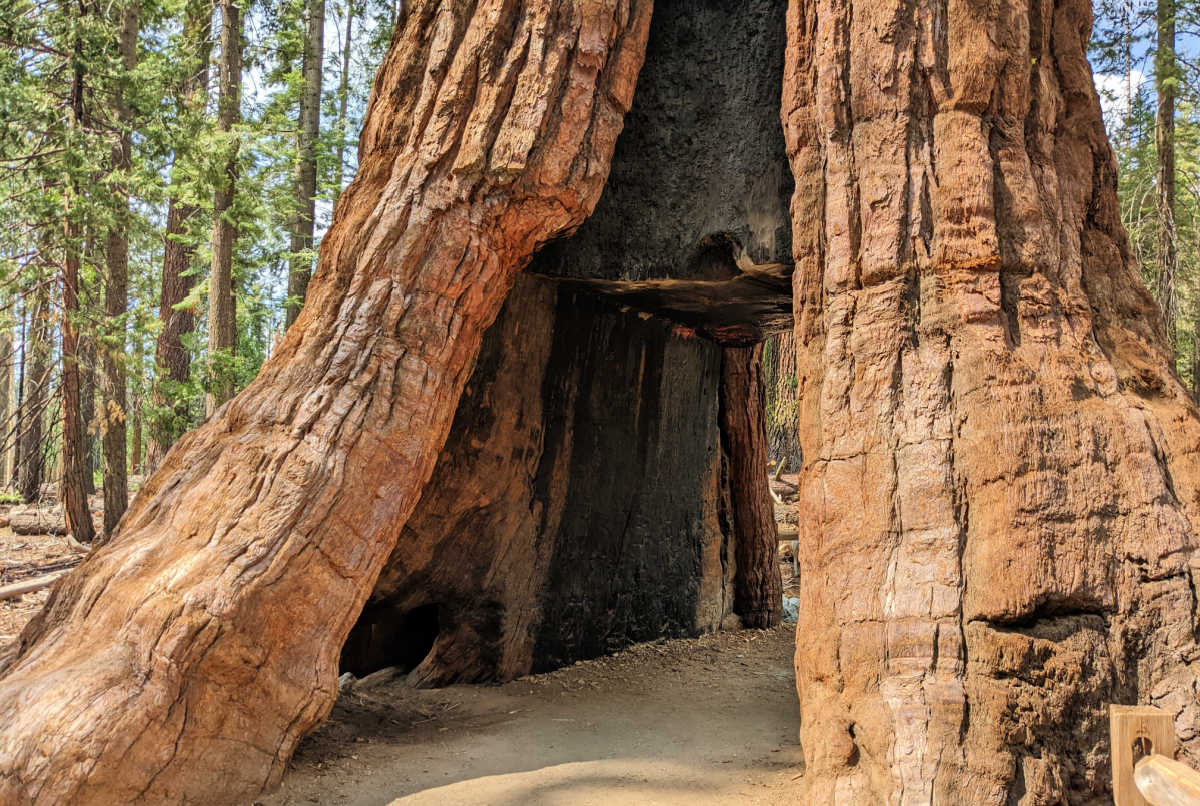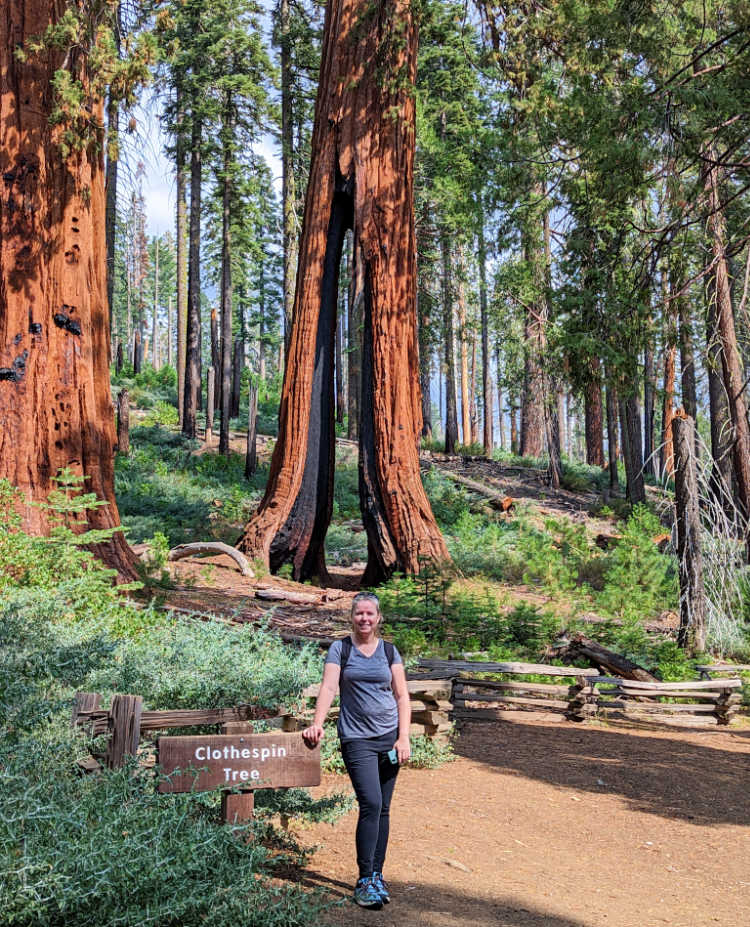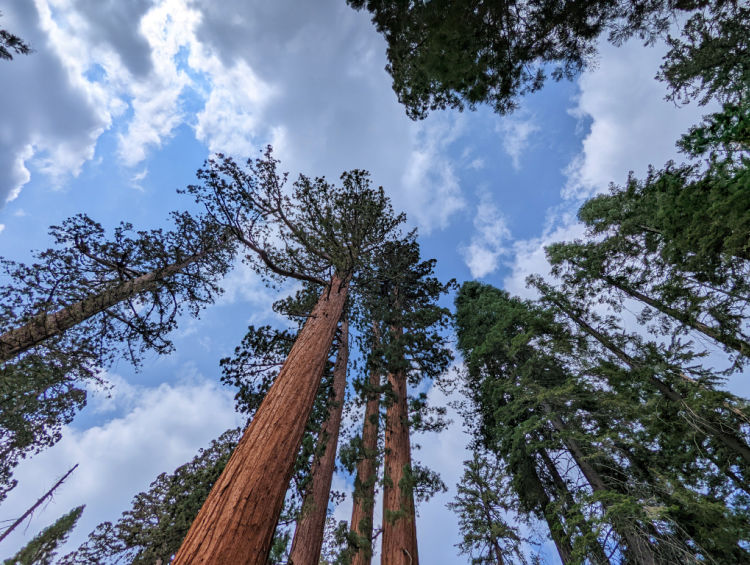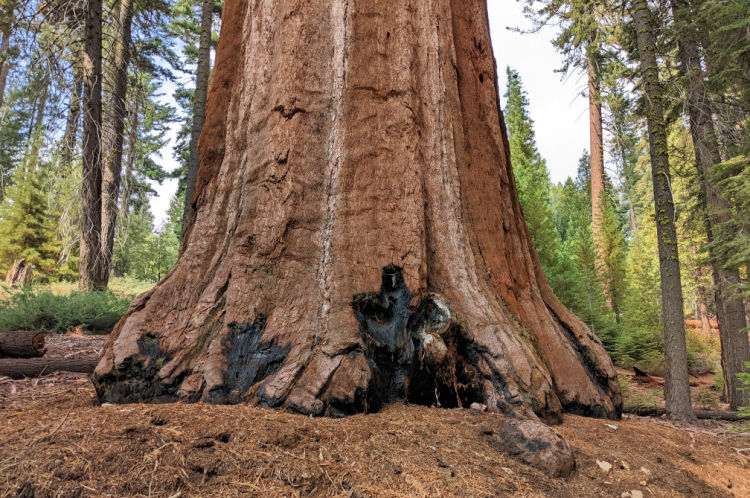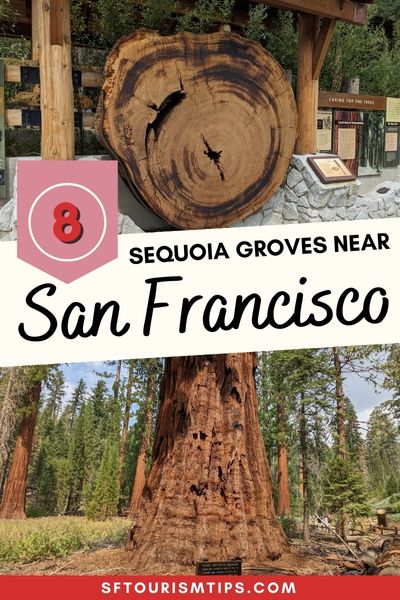SIGN UP FOR MY EMAIL TO RECEIVE YOUR FREE SAN FRANCISCO PLANNING GUIDE.
Sequoia Trees Near San Francisco: 8 Great Groves to Explore
By: Jill Loeffler • Updated: March 28, 2023 • Published: March 28, 2023
Are you searching for places to see towering sequoia trees near San Francisco? You'll find these giants about four hours east of the Bay Area along the western slopes of the Sierra Nevada Mountains.
My guide offers you details on the difference between sequoias and Coastal Redwoods, the best places to find them, and a few other details about these historic trees.
SFTourismTips is made possible by readers like you! If you book through my links, I may earn a small commission—at no extra cost to you. Thanks for your support! Learn more.
Difference Between Sequoia Trees and Coastal Redwoods
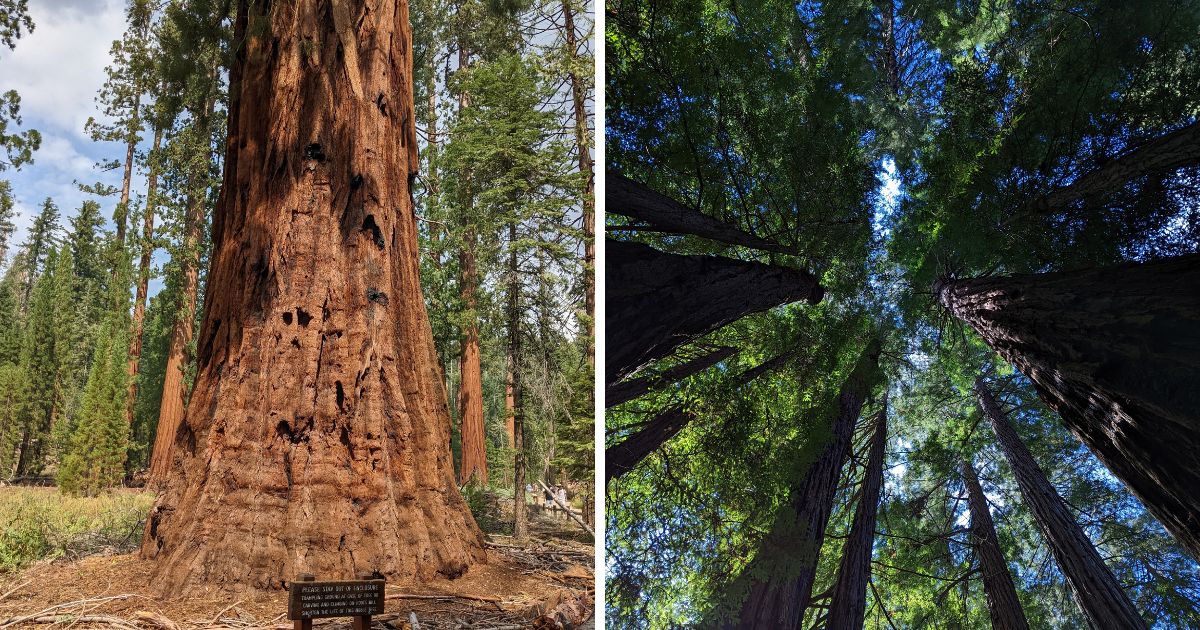 The one on the left is the base of a giant sequoia in Yosemite. The one on the right is a group of Coastal redwoods in Muir Woods.
The one on the left is the base of a giant sequoia in Yosemite. The one on the right is a group of Coastal redwoods in Muir Woods.There is little in nature to match the sheer majesty of the Giant Sequoia or the Coastal Redwood tree. You may have believed they are the same - many people do - but they are two distinct species from the Redwood family. What are the differences?
The Giant Sequoia grows naturally on California's western slopes of the Sierra Nevada mountains. It is found only in a 60-mile band of conifer forest in the mountains.
It is the biggest tree in the world - in that it has the widest girth (which means width) - but not the tallest. That accolade goes to its close relative, the Giant Redwood.
Coastal Redwoods are found along the coast of California from the northern edge of the state to the Big Sur region. They are the tallest trees in the world and can grow to a height of over 300 feet.
Another difference is the size of the pinecones. Those of the Sequoia are considerably larger than those from the Coastal Redwood. Luckily, both species live about the same amount of time, which can be for many hundreds of years.
In summary, the Sequoia is shorter and wider and grows in the mountains, and the Coastal Redwood is taller and thinner and grows on the coast.
>> Find my favorite redwoods near San Francisco
>> Find my favorite redwood parks near Monterey
Yosemite National Park
The world-famous Yosemite National Park - a designated World Heritage Site - is famous for its diverse landscape, flora, and fauna. Within the park - which covers almost 1,200 square miles - are three superb groves of Sequoia, which are one of the main attractions.
Surrounded by the Sierra and Stanislaus National Forests, Yosemite is 95% designated wilderness, and many visitors enjoy spectacular and unique landscapes and various activities.
Yosemite National Park is open year-round and, with 800 miles of trails, is very popular with hikers.
Great Guided Tours to Explore Yosemite
1. Mariposa Grove
The sheer majesty of the Giant Sequoias in Mariposa Grove can only be described as breathtaking. Here are more than 500 of the best examples of the species in what is the largest of the Sequoia groves in Yosemite.
Towering above visitors, these beautiful and unique trees can be viewed by taking one of several dedicated trails that walk you through them.
The Big Trees Loop is recommended for those who cannot manage a longer route, and at just 0.3 miles, it is accessible to wheelchair users. The Guardians Loop and Mariposa Grove Trail are more challenging trails, and each is considered moderate to strenuous.
When you are on these hikes, make sure to look for fallen trees, such as The Wawona Tunnel Tree, and famous living examples, The Bachelor and The Three Graces.
A shuttle service runs from the Mariposa Grove Welcome Plaza, where visitors can make use of restrooms, and be aware that while there are parking spaces for 300 cars, they tend to fill up by midday.
The shuttle does not run during the winter months - when the Mariposa Grove road is shut, so check in advance. Dogs are not permitted in the grove, and there are no food outlets, so pack a picnic.
>> More about visiting Mariposa Grove
2. Tuolumne Grove in Yosemite
There may only be a couple of dozen Giant Sequoias at Tuolumne Grove, but they are indeed spectacular. These mature trees are hundreds of years old and are fine examples of the species. Visitors should be aware in advance that the grove is quite remote.
The grove is open year-round, though it may only be possible to reach with skis or to wear snowshoes in icy weather or snow. However, it is a spectacular and exciting experience in such conditions.
An easy 1.5-mile walking trail takes visitors through the fantastic trees, and a more challenging example of 2.5 miles is popular with skiers. However, it is not wheelchair accessible.
Parking is limited at Tuolumne, so be prepared to get there early to enjoy your visit to the full. Bicycles are not permitted within the grove, though dogs are allowed on paved paths, not side trails.
3. Merced Grove in Yosemite
The smallest of Yosemite's three Sequoia groves is Merced Grove, accessible only on foot and a spectacular experience. With 20 magnificent standing Giant Sequoias, the trail through the grove is rated as difficult and is not wheelchair friendly. When you visit here, look for the old ranger park cabin, which is part of the rich history of the grove.
Merced Grove is open all year but may be difficult to reach without skis or snowshoes during winter. It is the quietest of the Yosemite groves in terms of visitors, so you are not likely to be overcrowded. Dogs are not permitted within the grove; cycling is also against the rules - the trails are strictly on foot.
Visitors are reminded to bring drinking water and food with them as there are no facilities within the remote and secluded grove. If getting back to nature is your thing, the majestic sequoias of Merced Grove are a must-see attraction.
Sequoia and Kings Canyon National Parks
Sequoia and Kings Canyon National Parks are managed by the same organization but are two distinct parks. Giant Sequoias can be seen in both, with a choice of Sequoia Groves to experience. The parks have identified 40 groves within the boundaries, with some featuring thousands of these astonishing trees!
As the sequoia grows and becomes part of a mixed conifer forest - and this only in happens naturally here in the Sierra Nevada Mountains - they tend to be the least numerous species in the groves, but their sheer size makes them the most dominant and awe-inspiring.
>> This is a fantastic self-guide audio tour for your visit to Kings Canyon
4. Giant Forest in Sequoia National Park
The most visited grove in the Sequoia National Park is the aptly named Giant Forest. Here you will see the largest living Sequoia of all - the famous General Sherman Tree - an incredible 36 feet in diameter at the base and some 275 feet tall. A paved path leads up to the tree and a wheelchair-accessible trail also, so pretty much most people can visit it.
The park offers access to many hiking trails of between one and two hours in duration, as well as longer examples that may take half a day. There is plenty of history to enjoy here, and you'll see old structures related to the days of cattle grazing in the area.
The Giant Forest Museum gives a fascinating insight into the region's history and culture; from there, visitors can drive to the parking lot, explore on foot, or take the regular shuttle bus to the grove.
5. Grant Grove in Kings Canyon
The most popular sequoia grove in Kings Canyon is Grant Grove, home to the magnificent General Grant Tree, famously celebrated yearly as the nation's Christmas tree. Kings Canyon is home to more large mature Sequoia than any other park, and there are many more named and spectacular trees to visit.
There is a 1/3-mile paved loop that takes in the General Grant and other attractions, and it is easy to reach from the Kings Canyon Visitor Center on foot. Shuttle buses run from nearby boarding points - including local campsites - in the summer months, and several more trails take you deeper into the 90-acre site.
While exploring Grant Grove, look for features such as the Gamlin Cabin - a wonderful historic building nestling amongst the magnificent trees - and the world-famous Fallen Monarch, which fell more than 300 years ago.
6. Redwood Mountain Grove
Within Kings Canyon is Redwood Mountain Grove, which suffered much fire damage in a major fire in 2021. The extent of the damage can be seen in the remains of the many sequoias sadly killed by the fire.
We advise potential visitors to check in advance as, at the time of writing, the grove is closed for safety reasons.
When Redwood Mountain reopens, visitors will access many miles of exciting and rewarding loop trails.
7. Muir Grove
Muir Grove is another Sequoia Grove affected by the fire that tore through the region in 2021. However, firefighters successfully prevented more severe damage, and the grove remains open for visitors. Quieter in terms of visitor numbers than other groves in the parks, Muir Grove is worth a visit for the many enjoyable hiking trails.
Look across the creek gorge east of the grove as you enter for a spectacular view of giant sequoias and walk among those within the grove. There is ample camping close by for those who want to spend more time in this tranquil and fascinating grove.
8. Calaveras Big Trees State Park
Calaveras Big Trees State Park, a few miles from the town of Arnold and in the Sierra Nevada Mountains, is considered the longest continually operating tourist attraction in California. Having welcomed visitors since 1852, it offers access to two stunning sequoia groves, which are pretty spectacular.
North Grove is home to around 100 mature Sequoia, while South Grove features around 1000. In the North Grove is the famous Pioneer Cabin Tree, which was once one of only two living 'tunnel trees' before its collapse in the storms of 2017.
Also, look for the largest tree in the grove, the Empire State, which is a colossal 30-foot diameter at the base.
South Grove features Lois Agassiz, the tallest tree in the park at 250ft, and also the second largest in the park - the Palace Hotel Tree - into which visitors can walk into thanks to a burn scar at the base. It is a great two-for-one since you get to see them both here.
The park is open year-round and includes two good-sized campsites, and it is worth spending a few days here to get the most out of your visit. Dogs are allowed in certain areas on a leash but not on the woodland trails, and there are plentiful hiking trails with different difficulty levels.
Activities include evening talks by park rangers, picnic areas, and activities for children. Visitors should be aware the road through the park is closed in winter, though North Grove remains easily accessible on foot during winter.

Hi, I'm Jill!
Dreaming of a San Francisco vacation? As a proud local, I'm here to share my insider tips and personal experiences to help you make the most of this iconic city!
Comments? Questions? Suggestions?
I would love for you to join me in my private Facebook group!
It's a great place to interact with me and others who know the area well.
You can ask questions, get advice for your upcoming stay, and then share your photos and advice with others when you return home. It's a great community and the fastest way to get answers to those nagging questions about your visit!
